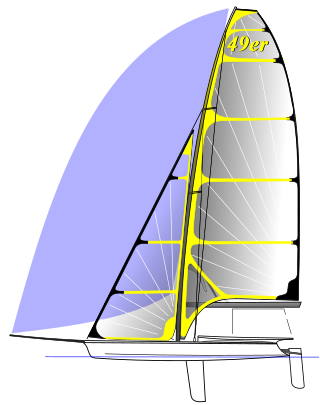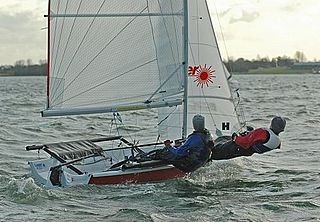Classic or traditional Punts
The older Punts are still very much in existence today and race in the same fleets as the newer boats. However, due to their rather more antiquated hull designs they compete on a handicap to allow fair racing. Boats designed and built as early as the late 1920s are still regularly seen on the water, with arguably the most successful Punt ever, dating back to 1935, winning four National Championships in the late 80s and in the top 3 as recently as 2023.
Amongst the early designers were such famous sailors as Uffa Fox and Jack Holt, although most successful boats were from the drawing boards of local designers, the most prolific being Herbert Woods, Walter Woods, H.T. Percival and W. F. Mollett. Early boats were generally of clinker construction and varied from 16 to 22 ft (4.9 to 6.7 m), although once in the 1930s pretty much all the designs were 22 ft (6.7 m). Initially gaff rigs were the norm, but as the class entered the 1930s Punt owners adopted Bermuda rigs.
Today many of the early Punts have been lovingly and painstakingly renovated or rebuilt, transformed into varnished works of art. Some have been brought into the 21st century, sporting carbon spars, trapezes and composite sails atop their beautiful, near-century-old clinker hulls. Whatever the owners' personal choices, these older boats are well loved and still very fast, offering near- 29er-type speed in an elegant package.
One-design Punts
In the eight years immediately after World War II only one boat was built, and it became apparent that the post-World War II economy meant that a new breed of boat needed to be designed, if the class was not to disappear into ignominy. Dick Wyche of Wyche and Coppock designed a 22-foot (6.7 m) boat made of plywood that proved far cheaper to build and far lighter and faster to sail. This design hustled the class into a new era, with the next 25 boats being built to Dick Wyche's plans, and with the class incorporating the trapeze in the 1960s and offering a fibreglass alternative in the 70s. In the late 70s the Wyche and Coppock Punt had the distinction of being the fastest dinghy in production.
To this day, the 'hard chine' Punt is a favourite of many, possibly because of its exceptional performance in light to medium conditions, and is still as much in production as ever; of the fourteen Punts built since 2000, eight have been to this design. However, once again owners' preferences have caused rig configurations to vary, from aluminium to carbon spars, single or twin trapezes and symmetric or asymmetric spinnakers.
Development years
After 32 years of design 'hiatus', the one-design progression of the class was shattered by the return of development. Andy Wolstenholme's prototype double-chine design led the charge, showing just how much faster the Punt could be. This was followed by the most numerically popular of the "Progress" designs, coming from the board of the world-renowned dinghy designer, Phil Morrison, whose cold-moulded modern hull proved to be blisteringly fast with a class PY rating of 856.
Designs from Fabian Bush, David Horne and Stephen Jones broadened the spectrum and appeal of the class, with hull lengths from 19 to 22 ft (5.8 to 6.7 m) and diverse construction materials – sheet ply, clinker planks, cold moulded wood, fibreglass, carbon and Kevlar – can be found in the development fleet. As with the "hard chine" fleet, rig configurations vary, from aluminium to carbon spars, single or twin trapezes and symmetric or asymmetric spinnakers. These “Progress” designs have traveled the length and breadth of the UK to compete in some of the bigger one-off handicap regattas such as the Grafham Grand Prix, the Bloody Mary, etc. As long as the conditions are appropriate (i.e. no waves), the boats and the sailors acquit themselves favourably against the mainstream competition.

Dinghy sailing is the activity of sailing small boats by using five essential controls:

The Enterprise is a Bermuda rigged sailing dinghy with a double-chined hull and distinctive blue sails. Normally crewed by two, and sometimes carrying a third crew member, it may also be sailed single-handed.

The 49er and 49er FX is a two-handed skiff-type high-performance sailing dinghy. The two crew work on different roles with the helm making many tactical decisions, as well as steering, and the crew doing most of the sail control. Both of the crew are equipped with their own trapeze and sailing is done while cantilevered over the water to the fullest extent to balance against the sails.

The International 505 is a One-Design high-performance two-person monohull planing sailing dinghy, with spinnaker, utilising a trapeze for the crew.

The Cadet is a class of sailing dinghy designed to be sailed by two children up to the age of 17. It is a one-design class, originally designed by Jack Holt in 1947. Cadets are sailed worldwide in more than 40 countries.

The Fireball is a British sailing dinghy that was designed by Peter Milne as a one-design racer and first built in 1962.

The Laser 4000 is a racing dinghy designed by Phil Morrison crewed by two persons. Its one-design weight-equalised system enables physically differing sailors to compete on a level playing field. It is most popular in Europe, particularly the UK, France and Italy.

The Tasar is a 14.83-foot (4.52 m) fiberglass 2 person sailing dinghy with a mainsail and jib. Designed by Frank Bethwaite of Sydney in 1975, the boat was technologically advanced for its time and continues to evolve. Aimed at a husband-and-wife or parent-and-child crew hence no spinnaker, it is designed for a combined crew weight of around 140 kg. The hull weighs 68 kg, and is of sandwich foam construction. The hull has a fine angle at the bow to reduce wave impact drag with unusually clean and sharp chines aft to ensure very free planing and outstanding stability. The foam cored hull is stiff and light and the advanced hull shape, together with an innovative rig which combines a rotating mast with a fully battened main sail, allows the Tasar to plane upwind with the crew normally hiked. The wide beam and a cockpit designed for comfortable hiking make the Tasar easy, fun and very exciting to sail in winds up to 25 knots (46 km/h).

The 18 ft Skiff is considered the fastest class of sailing skiffs. The class has a long history beginning with races on Sydney Harbour, Australia in 1892 and later in New Zealand. The boat has changed significantly since the early days, bringing in new technology as it became available. Because of the need of strength, agility and skill, the class is considered to be the top level of small boat sailing. Worldwide this boat is called the "18 Foot Skiff". It is the fastest conventional non-foiling monohull on the yardstick rating, with a score of 675, coming only third after the Tornado and Inter 20.

The International 14 is a British racing sailboat, crewed by two sailors. The class was established in 1928.

The Merlin Rocket is a 14 foot (4.3 m) dinghy sailed in the United Kingdom. It is an active class, now with over 3800 boats built.

Otter is a classification referring to a particular design for a two-man sailing dinghy with a glass fibre hull. Its rig consists of a main, a jib and an optional symmetric spinnaker. The hull dimensions are 11 ft 11 in length and 4 ft 10 in beam. The boat has a draft of 3 ft 6 in with the centreboard down. The sail area is 75 sq. ft. The class symbol is a stylised glass bubble; due to the original lightweight "cigar box cedar" construction of the prototypes, the name 'Bubble' was first used for the boat. John Baker obtained the plans for an expanded version of the boat in G.R.P. and hence renamed the boat 'Glass Bubble'. After being put into production by Baker, the name 'Otter' was adopted; coming from the river of the same name in East Devon, close to where the boat was manufactured.

The Cherub is a 12 feet long, high performance, two-person, planing dinghy first designed in 1951 in New Zealand by John Spencer. The class is a development class, allowing for significant variation in design between different boats within the rule framework. The minimum hull weight was originally 110 lbs.

The 3000 is a racing sailing dinghy crewed by two persons with a trapeze for the crew. Launched in 1996 as the Laser 3000, the 3000 was developed from the Laser 2, using the original Frank Bethwaite-designed planing hull combined with a new designed self-draining deck by Derek Clark. Clark also re-designed the rig, using spars and sails from premium proprietary sources and replacing the symmetric spinnaker of the Laser 2 by a larger asymmetric spinnaker (gennaker). The gennaker is chute-launched and retrieved using a single halyard line, and is set on a retractable bowsprit. Helm balance and handling were improved using a shorter-footed mainsail with two full-width battens giving a larger roach. A mast with conventional spreaders replaced the now-unusual diamond arrangement of the Laser 2.

The Phantom is a British sailing dinghy that was designed by Paul Wright and Brian Taylor as a one-design racer and first built in 1971.

The NS14 is an Australian restricted development class of sailing dinghy. Measuring 14 feet in length, the class was designed the 1960 and introduced at the Northbridge sailing club in Sydney, Australia, with control of the class transferred to the NS14 Association of New South Wales in 1965. Subsequently the boat was introduced to the other states, prior to being taken to New Zealand in 1995 and the United States in 1998.

The Laser Vago is a British/American sailing dinghy that was designed by Jo Richards as a one-design racer and first built in 2005.
A 16 ft Skiff is a class of three-person sailing dinghy with twin trapezes and a large asymmetrical spinnaker. The class is unique to Australia, where it is one of the most popular boats sailing with 95 boats registered in 12 clubs. The class has the largest fleet of high performance skiffs on the east coast of Australia. Due to the nature of only allowing two trapezes, the age of the sailors can vary between 15 and 60 years old, making it a versatile class of boat.
The Skate is a high performance two-person racing dinghy unique to Australia. Designed as a monohull sailboat it's fourteen feet long (4.27m) with a 7.2m mast, 1.8m bow pole and masthead asymmetrical spinnaker. It is an Australian national class.

The Hampton One-Design is an American sailing dinghy that was designed by Vincent Serio as a one-design racer and first built in 1934.

















